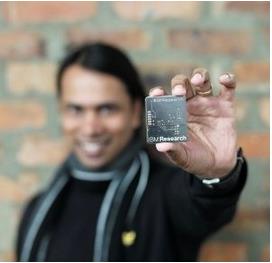Release date: 2016-10-19
According to the World Health Organization (WHO), about 80% of South Africa's population has latent tuberculosis, and in 2013 alone, there were 45 tuberculosis-positive patients. The fatality rate of tuberculosis surpassed AIDS last year and became the world's deadliest infectious disease.
About 37.5% of tuberculosis patients worldwide are undiagnosed, and undiagnosed means no treatment options. It can be said that this is a detection link, or a defect in the treatment link. These patients continue to infect new patients, leading to a vicious circle of disease spreading in the population. The diagnosis of these patients will help advance the treatment of tuberculosis, which is why IBM supports the WHO tuberculosis termination strategy. IBM provided WHO with a data-driven IoT system to diagnose, predict, and ultimately stop the spread of tuberculosis.
The biggest problem in tracking infectious diseases is that the disease surveillance information reporting management system is regulated by different health agencies. The results of the survey still need to be manually entered into the system, which will inevitably lead to omissions, input errors and other issues. In addition, in South Africa, tuberculosis is marked by social prejudice, so many tuberculosis patients are reluctant to provide relevant information.

Researcher Toby Kurien took a small radio tuberculosis tracker in his hand.
Developed by IBM Research Africa Manufacturing Lab
In the Johannesburg lab, which was put into use not long ago, IBM researchers are trying to solve the problem of data-driven methods and want to design a more effective strategy for preventing and controlling TB. Using cheap radio tags, the research team plans to place dozens of radio tags in specific areas of Johannesburg to anonymously track the path of tuberculosis.
Researchers Toby Kurien and Darlington Shingirirai work in laboratories at Braamfontein's headquarters. They try to commercialize radio tags and apply them to hospitals, clinics, etc., and eventually to the community. Kurien is a well-known engineer in the local manufacturing industry and has joined the tracker development process. Darlington is a Ph.D. in bioinformatics. He joined the IBM Africa Institute eight months ago, and his participation in medical health research is no different.
How to track tuberculosis more effectively
In general, radio frequency trackers have limited use and can only work in a specific area, such as a mall. However, the radio frequency tracker has a limited transmission and reception distance, and it is difficult for the monitor to judge who is within the scope of monitoring, and who has just entered the monitoring range. Therefore, in similar shopping malls or other special places, the effect of the radio frequency tracker will be greatly reduced.
However, the radio tags of Kurien and Shingirriai solve the problem of the transmission and reception distance of the tracker.
Kurien said: "Our radio tags can communicate with each other, so when two radio tags are interconnected, their interaction records are recorded." For example, a patient carrying a tag may enter separately with another ten. The communication range of the patients carrying the label will be communicated one by one between the two labels (eight people on the bus and three people at home). If each patient carries this radio tag, the communication between each two tags will be recorded one by one.

This allows for the design of a targeted immunization strategy.
The data collected from the radio tags will be presented on a three-dimensional dynamic monitoring display that scientists and researchers can use to analyze the distribution of disease and even track the path of disease. At the same time, because the cost of vaccination is too high, these data can also help medical personnel to identify priority immunization patients.
“These tags are responsible for collecting data,†Kurien said. “We visualize the collected data to determine the distribution of the disease. When we find a disease that is dense, it means there is a Labeled patients enter this densely populated range of people, and we refer to such people as 'super liaisons' or highly concentrated people. These data show that if we choose a super liaison for vaccination, this It means that we can break this dense network and stop the spread of the disease."
Shingirirai said: “By using these tags, we can analyze the pattern of disease transmission in different populations. This information not only plays a vital role in preventing disease transmission, but also in analyzing disease transmission mechanisms and in different environments. It plays an essential role in the sense of the population. This allows us to develop more effective interventions, such as targeted immunization (isoniazid preventive treatment), strengthening the detection of tuberculosis patients, infection control and Other measures to prevent the spread of disease."
In addition to the mishandling of data extraction, another reason for the difficulty in tracking TB is that traditional tools such as GPS sensors are not only expensive, but more importantly, patients are reluctant to carry them. These trackers used for medical data collection are often considered to be infringing on private privacy. Another more sensitive issue is that wearing a tracker is tantamount to telling others that they are TB patients.
After learning about these issues, the technical team designed the third generation of trackers, the smallest version. Kurien tells us: "Each chip contains a small sensor, storage device and battery. We make the chip into a bracelet size, and then with a stylish shell, so that others can not see the wearer is a tuberculosis patient." Shingirirai pointed out that in order to reduce the visibility of the tracker, they can also make it into the form of a headband (female patient) or a wristband (male patient).
With these design ideas, the technical team worked with local startup technology company SiGNL to manufacture these trackers. They plan to conduct the first test of the batch of trackers in a controlled environment (such as a hospital), and then put them into mass use after meeting the requirements. This tracker can also be used to track other types of infectious diseases.
“The more knowledge we learn, the deeper our understanding of things. When our understanding of things begins to deepen, the actions we take will naturally be more positive. In this case, we are with tuberculosis. The fight has had a huge impact."
In order to support the WHO TB termination strategy, the infectious disease tracker developed by IBM is not only an innovative invention, but also a practical tool. It not only contributes valuable data that enhances human health and safety, but also eliminates the drawbacks of existing trackers at the social level and solves the cost problem.
Source: Lei Feng Net
Plant extracts refer to substances extracted or processed from plants (all or a part of plants) using appropriate solvents or methods, and can be used in the pharmaceutical industry, food industry, daily chemical industry and other industries.

There is a conceptual overlap between plant extracts and herbal extracts. The raw materials of plant extracts in my country are mainly derived from Chinese herbal medicines, so domestic plant extracts can also be called Chinese medicine extracts to some extent.

Herbal Extract,Liquid Herbal Extracts,Herbal Extract Powder,Natural Herbal Extract
XI AN RHINE BIOLOGICAL TECHNOLOGY CO.,LTD , https://www.xianrhinebiotech.com